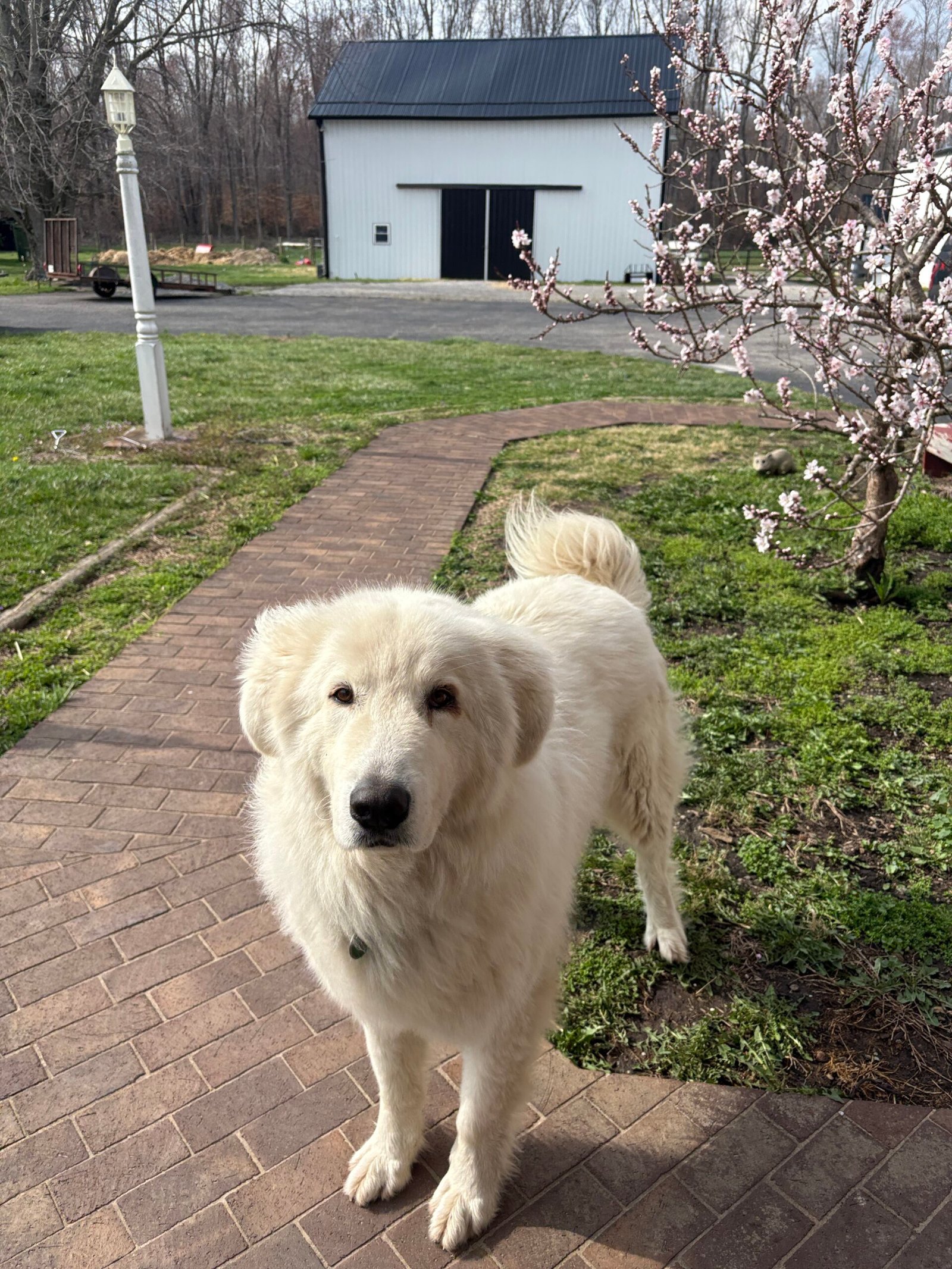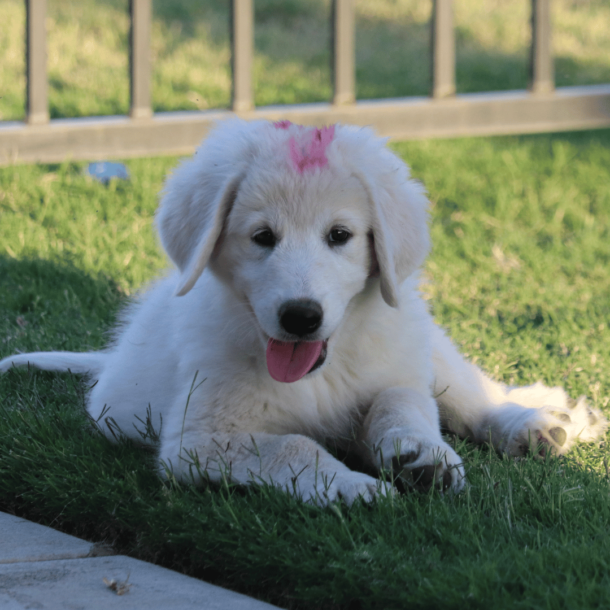Last Updated on November 6, 2025 by Kim Crawmer, KPA CTP, LFDM
Planning Ahead: Why Timing Matters When Adding a Livestock Guardian Dog to Your Farm
Unlike bringing home a pet dog – where you might only need a few days off work to help a puppy settle in – adding a Livestock Guardian Dog to your farm requires careful coordination of multiple factors: predator pressure, livestock acquisition, proper fencing, training time, and overall farm development.
Here at Prancing Pony Farm, I’ve witnessed firsthand how advance planning makes all the difference between a smooth integration and a stressful scramble. Let me share why thoughtful timing matters, and why securing your place on our waiting list early gives you significant advantages.

The “Emergency Scenario” No Farmer Wants
I’ll never forget the urgent call I received from a client with a small goat operation in Central California. His voice trembled with grief and worry.
“My livestock guardian dog died suddenly yesterday,” he explained. “Now I have nothing protecting my herd from the coyotes.”
He needed a replacement immediately—not in three months when the next litter would be ready, not in six months when adolescents would be properly trained. He needed protection right now.
Unfortunately, I had just placed my last two available Maremmas that day. His only option was to buy questionable quality dogs from Craigslist and hope for the best.
This scenario happens more often than you might think and is completely avoidable with proper planning. This is another reason (among many) why we highly recommend everyone have at least two livestock guardian dogs, no matter the size of their farm.

Quality LGDs Aren’t Mass-Produced
At Prancing Pony Farm, each Maremma Sheepdog puppy receives:
- Birth in our specially-designed Puppy Parlor within the goat pasture
- Intensive socialization with multiple livestock species from day one
- Comprehensive health testing of their parents to protect puppies against developing hereditary diseases
- Early training foundations using positive reinforcement
- Careful health monitoring and appropriate veterinary care
This level of care means we can only produce a limited number of exceptional guardians each year. When clients reserve ahead, it allows us to:
- Plan appropriate breedings based on real need
- Match puppies precisely to each farm’s specific situation
- Socialize puppies for a wide variety of homes and needs
- Time availability to coincide with your farm development and livestock acquisition

The High Cost of “Affordability” Over Quality
During the pandemic pet boom, many backyard breeders thought breeding livestock guardian dogs would be “easy money.” They produced a glut of poorly bred, improperly socialized Livestock Guardian Dogs. While these puppies were readily available with no waiting, many farm owners discovered the hard way that an improperly bred or trained LGD can cause more problems than it solves.
One client named Cristi learned this lesson the hard way. She originally inquired about buying a puppy from us but decided to buy a more “affordable” puppy closer to Indiana, where she lives. She purchased an adolescent Maremma named Maggie from a breeder without experience in training and socializing LGDs. I’m not exactly sure what that breeder did or didn’t do with her puppies, but within days of buying that dog, Cristi realized she had made a big mistake. The breeder couldn’t even advise her on handling the issues she was dealing with.
She contacted me for advice. The first thing I told her was that Maggie needed a partner. Then, I gave her more advice on dealing with Maggie’s issues. Not long after, she bought Daxo, an 18-month-old neutered male Maremma, from us as a partner and guide for Maggie. As she has said repeatedly, Daxo has been a wonderful livestock guardian dog and a huge asset to her farm. “Plug & Play,” as she said in her Google review of our program.
She still owns Maggie but says she can’t trust her as a livestock guardian dog and wasn’t looking for a pet, so her plan to save money by buying her was a big mistake. “I wish I’d just reserved a dog from you when I first contacted you,” she told me. I would have had the right dog from the start.”

Age Options: Choosing What’s Right for Your Farm
One advantage of planning ahead is the ability to select the perfect age for your specific situation:
3-5 Month Old Puppies:
- Excellent for those who want to shape the dog’s early experiences
- Ideal if you enjoy the puppy stage and have time for supervision
- Most affordable option but requires the most developmental guidance
6-12 Month Old Adolescents:
- Already have solid livestock socialization foundations
- More physically capable of deterring predators than young puppies
- Past the most intensive puppy stage but still adaptable to new environments
- Middle ground between puppies and adults in both price and training needs
1-2 Year Old Adolescents
- Big enough to deter most predators
- Past a lot of the rambunctious puppy stage and generally more trustworthy with stock (but still not considered an adult)
- Still young enough to adapt to a new home and family
- Not considered a fully trained adult, but a lot closer to the goal
Adult Trained Guardians:
- Immediate protection capability
- Already tested working ability and temperament
- Less daily training is required to establish proper behavior
- Ideal for immediate predator-pressure situations
- Higher investment reflects their complete training and proven capabilities
- Can require a bit more time to adapt and adjust to new people
By reserving early, you can specify exactly which age range best suits your farm’s timeline and needs.

Planning Timeline for LGD Success
The most successful Livestock Guardian Dog placements follow this timeline:
1. 6-12 months before you need protection: Research breeds and breeders understand costs and requirements
2. 3-6 months before: Secure your place on a quality breeder’s waiting list.
3. 1-3 months before: Prepare your farm with appropriate fencing, shelter, and introduction areas. Start learning about dog training and behavior through science-based resources.
4. Arrival time: Have livestock in place or arriving shortly after your LGD. (You can push this out a bit if your puppy was properly socialized with livestock during the first 12-16 weeks.)
5. First 2-4 weeks: Implement proper introduction protocols with breeder support

Taking Action Now Prevents Problems Later
Whether you need a Maremma Sheepdog now or are planning for months or even a year from now, the time to begin the conversation is today. Our clients who secured their reservations months in advance have the peace of mind of knowing exactly when their livestock guardian dog will arrive and that it will be perfectly matched to their specific needs.
As one client recently told me: “Getting on your waiting list was the best farm planning decision we made. It gave us a clear timeline to work toward with our fencing and livestock acquisitions, and when the time came, we had exactly the right dog waiting for us.”
Ready to secure your farm’s protection with a Prancing Pony Farm Maremma Sheepdog? Reserve your puppy today, or explore our currently available livestock guardians for more immediate needs.


